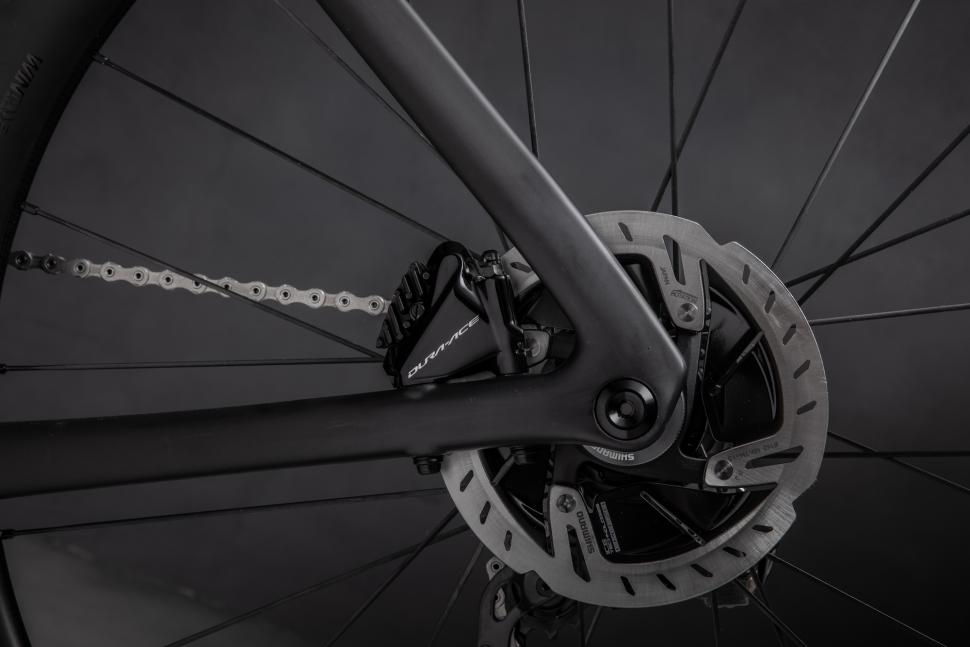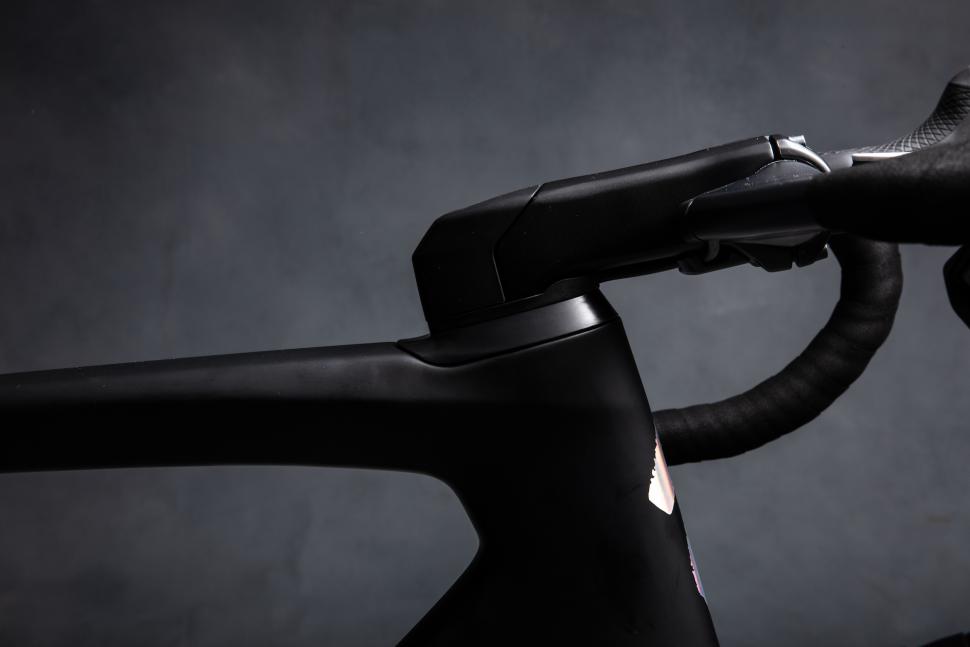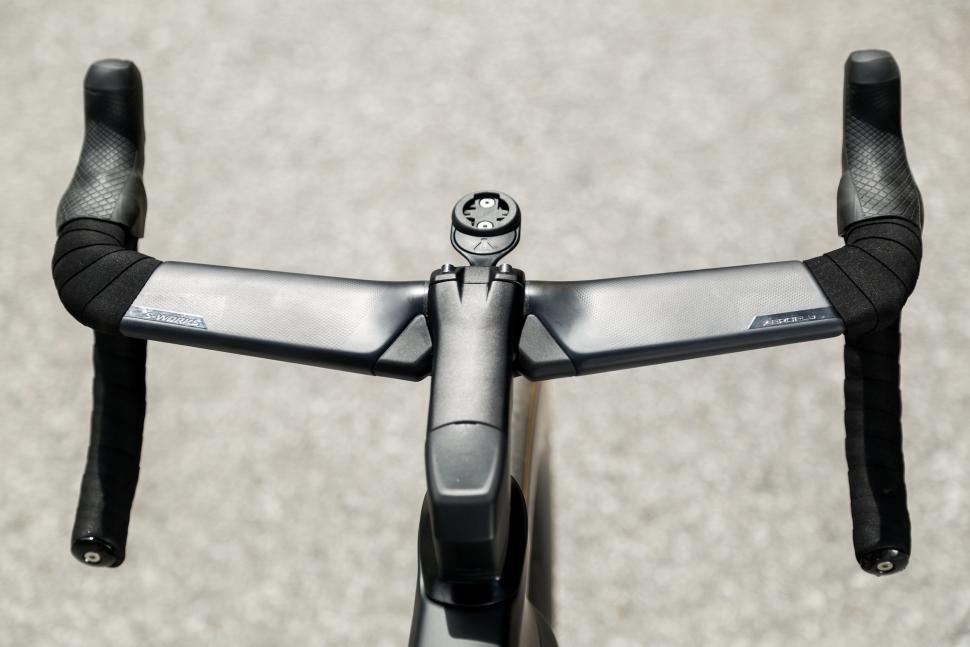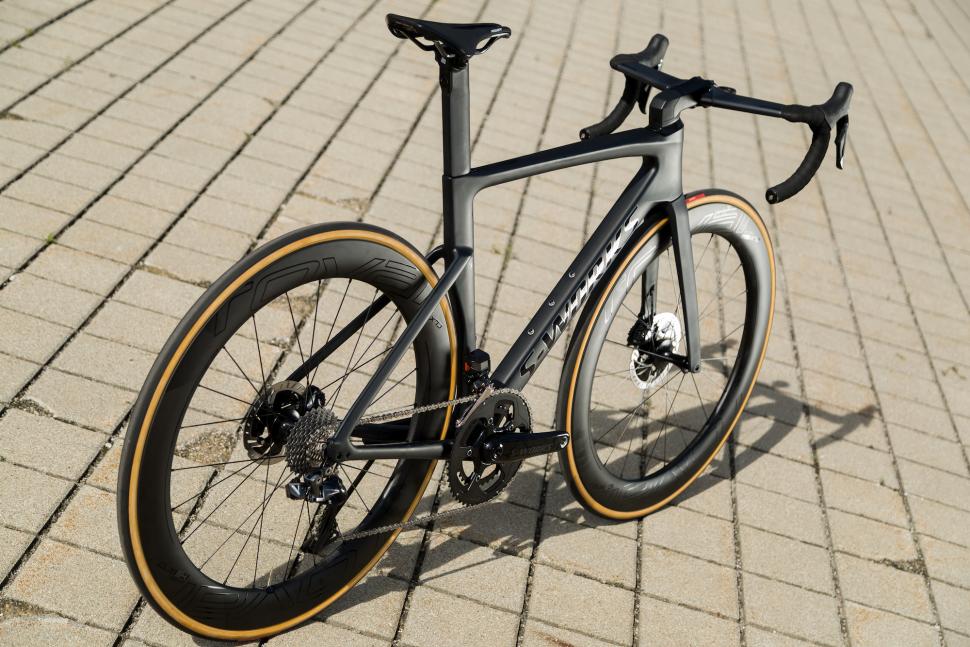- News
- Reviews
- Bikes
- Components
- Bar tape & grips
- Bottom brackets
- Brake & gear cables
- Brake & STI levers
- Brake pads & spares
- Brakes
- Cassettes & freewheels
- Chains
- Chainsets & chainrings
- Derailleurs - front
- Derailleurs - rear
- Forks
- Gear levers & shifters
- Groupsets
- Handlebars & extensions
- Headsets
- Hubs
- Inner tubes
- Pedals
- Quick releases & skewers
- Saddles
- Seatposts
- Stems
- Wheels
- Tyres
- Tubeless valves
- Accessories
- Accessories - misc
- Computer mounts
- Bags
- Bar ends
- Bike bags & cases
- Bottle cages
- Bottles
- Cameras
- Car racks
- Child seats
- Computers
- Glasses
- GPS units
- Helmets
- Lights - front
- Lights - rear
- Lights - sets
- Locks
- Mirrors
- Mudguards
- Racks
- Pumps & CO2 inflators
- Puncture kits
- Reflectives
- Smart watches
- Stands and racks
- Trailers
- Clothing
- Health, fitness and nutrition
- Tools and workshop
- Miscellaneous
- Buyers Guides
- Features
- Forum
- Recommends
- Podcast
TECH NEWS
Specialized Venge 2019 - All-new aero frame with discs and electronic gears only
Specialized has radically redesigned its Venge aero road bike with an all-new frame and fork that is lighter, faster and better handling than the previous bike. Oh, and it’s only available with disc brakes and electronic gears.
It has been seven years since Specialized launched the first Venge. At the time it was one of the first fully aerodynamic road bikes that attempted to bring some of the drag reducing features from a time trial bike to a road race bike. Since then the development of aero road bikes, and all manner of aero products from helmets to clothing to handlebars has hugely increased.
- 17 of the best and fastest 2018 aero road bikes — wind-cheating bikes with an extra turn of speed
In the hugely competitive arena of pro bike racing, it’s no surprise racers have readily adopted aerodynamic products. They want to gain an advantage over their rivals and speed matters, as well as reducing the effort required to ride at any given speed.
Committed to aero
Specialized knows this and it’s why it’s committed to the performance advantages that aerodynamics can provide, as it was keen to remind us at its launch event recently. That commitment even led to the building of its own wind tunnel, which opened a few years back, providing unlimited access to the most important tool in validating new aerodynamic designs. It's a clear advantage over its rivals who have to book time at the nearest wind tunnel.
The original Venge was no slouch. It won Milan-San Remo on its first outing at the hands of Matthew Goss despite a script that clearly favoured his HTC-Highroad teammate Mark Cavendish. That bike, if you need reminding, was developed with Formula One team, McLaren. If you want a trip down memory lane, here’s what aero bikes looked like back in 2012.
The second generation Venge ViAS followed and scored many victories over the years. The original rim brake version was soon being joined by a disc brake model, one of the first disc-equipped aero road bikes onto the market. And so to the new bike, which if you’ve been paying attention you'll have seen already, has already won races even before it launched with Peter Sagan and Elia Viviani winning their respective national championships on the new bike.
- 2018 WorldTour race bikes - The complete list of this year's race bikes
Despite the clear benefits that aero bikes present, they are still compromised in some way or another, whether it’s weight, handling or complexity. Those are the drawbacks that Specialized has attempted to address with the third-generation Venge, but it has arguably introduced other compromises in only supporting disc brakes and electronic gearing, though it has valid reasons for these choices.
Here are five things you need to know about the new Venge.
1. It’s more aerodynamic than the old Venge
Well, you’d hope so wouldn’t you? Specialized is claiming the new Venge is 8 seconds faster than the old Venge ViAS over 40km at 0-degree yaw, though it doesn't state at what speed that test was conducted. Throw in some crosswinds as you get in real-world riding conditions and the new bike is faster still says Specialized. We can only really take aero claims at face value.
Specialized actually started designing the new Venge by first developing its own Free Shape Optimisation software that could generate millions of tube shapes and analyse them based on aerodynamics, surface area and stiffness. Specialized isn't just taking a tube profile off the shelf, it wanted to develop tube shapes that met its particular requirements. Chris Yu describes this as the company’s trump card.
And visually it’s a markedly different looking bike to the old one. Better, in my opinion, with some of the sharpness of the Tarmac SL6 evident in the new Venge. But what do you think? Jump down to the comments to let me know.
The curvy downtube has been replaced by an arrow straight downtube, there’s a new semi-integrated handlebar and stem, all-new rear stays and an aero seatpost. It has been designed entirely around disc brakes, there is no rim brake option at all. Specialized feels the benefits of disc brakes far outweigh any negatives.
One of those positives is improved tyre clearance. The Venge will take a massive (for an aero road bike) 32mm tyre. Fit a set of Roubaix 30-32mm tyres at 50psi to 21mm internal width Roval rims and there’s 1.5mm clearance at the tightest spot.
All bikes will come specced with pro favourite 26mm Turbo tyres but if you want to go wider because you’re not racing and want a bit of extra comfort for dealing with poorly surface roads, there are plenty of options for you.
2. Disc brakes and electronic gears only
Yup, that's no typo, the Venge is only available with discs and electronic gears.
In the pursuit of improved aerodynamics, Specialized has committed the new Venge to disc brakes and electronic gears. There’s no rim brake or mechanical groupset version at all. Well not yet anyway, we all saw what happened with the special rim brake Roubaix didn't we?
That’s less likely to happen with this new bike, given it’s won a couple of big races already and is likely to be a key bike in Quickstep and Bora’s lineups at the upcoming Tour de France.
Disc brake standards have thankfully settled down and the Venge uses the flat mount interface with a 142x12mm rear axle and 100x12mm front. By default, the Venge comes with bolt-on axles requiring a 6mm Allen key, which at a claimed 67g/pair are half the weight of standard quick release axles. DT RWS ratcheting handles are available if you prefer tool-free wheel removal.
The decision to only accommodate electronic groupsets is easier to appreciate when you consider this is clearly a bike aimed at professional and top-level racers where electronic gears are the most common choice.
But it also comes about because there are fewer compromises in having to factor in cable routing for a mechanical groupset. If you’re striving for optimum aerodynamics why then introduce a compromise like cable routing, is Specialized’s thinking.
Of course, the downside is that it immediately sets the entry price high as Shimano only goes down to Ultegra with its electronic Di2 setup, and SRAM is still at Red level with eTap. Could Specialized develop a mechanical version in the future? Probably, but with certain compromises to its core aim of being as fast as possible.
At launch, there are only Shimano Di2 models to choose from. We’d suspect a SRAM Red eTap version could be added, given the popularity of that groupset.
The Di2 junction box has also been relocated to the back of the seatpost saddle clamp and this is due to feedback from the pros. The main benefit is that it allows team mechanics to access it more easily when leaning out of a car window than if it were located in the down tube or handlebar.
Specialized has managed to fit a standard Di2 battery inside the aero seatpost. It’s a snug fit we’re told.
3. User-friendly and adjustable integrated aero handlebars
The integrated handlebar and stem of the previous Venge ViAS have been completely reworked, and as well as looking a lot nicer, it’s much easier to adapt to different fit requirements.
It starts with the new Aerofly II handlebar, which drops the Hover rise of the previous bar with a flat aero profile that is faster, lighter and stiffer than that previous design. All cables and brake hoses are internally routed and there are textured patterns on the top for extra grip.
The big news is the all-new stem, which Specialized claims exceed the stiffness of any stem it has tested including the one that Peter Sagan typically favours, the Zipp SL Sprint stem.
The new stem takes the internally routed cables and hoses from the handlebar and passes them directly into the frame via a small cover on the underside of the stem. It’s not dissimilar to the BMC Teamachine and should provide easier setup whilst maintaining optimum aerodynamics.
This new stem sits atop an aero spacer recessed into the top tube and a plastic shroud covers the rear section of the stem, and it can be easily removed for making any stem adjustments. There’ll be computer mounts for floating a Garmin or Wahoo computer out front as well.
The new stem and handlebar come in a wide variety of sizes. Thee 6-degree stem comes in 80, 90, 100, 110, 120 and 130mm lengths and the 12-degree version comes in 110, 120, 130 and 140mm. The Aerofly II handlebars come in four widths from 380 to 440mm.
If you prefer your own stem or handlebar, either or both can be swapped, you’re not tied into a proprietary solution here. The Aerofly II handlebar is compatible with a regular stem, and the new stem will work with any 31.8mm handlebar. There’s a transition spacer that is needed to sit on the frame but that’s it.
Aero bikes also make useful time trial bikes, and Specialized has made a clamp that lets you use its existing ViAS clip-on aero bar with the new Venge. It’s a one-piece carbon fibre extension available in two lengths.
4. Lighter than previous Venge ViAS and Tarmac SL5 Disc
There’s little disputing the speed of an aero bike, but they are typically compromised when you put them on the scales. There’s no getting around it, those bigger aero shaped profiles weigh more than a simple skinny round tube.
In an ideal world you’d have the weight of a climbing bike with the aerodynamics of a time trial bike, but while that’s not possible yet the new Venge is a substantial push forward in reducing the previous weight penalty that would put many racers and customers of choosing an aero bike.
A 56cm size frame weighs a claimed 960g, a massive 240g saving over the old bike. The new fork saves a further 25g, the bar and stem 107g, the seatpost drops 25g and the small parts another 63g. Added up, the new Venge module saves 460g compared to the old Venge ViAS.
Add some equipment, a Dura-Ace Di2 groupset and Specialized’s own power meter, new Aerofly II handlebar and Roval CLX64 clincher wheels as you get on the S-Works model, and you're looking at 7.1kg in a size 56cm. You can imagine with a change to tubular or shallower carbon wheels that the weight would easily go sub-7kg.
And no you don't need to pay nearly £500 to unlock the power meter as you do with the Cannondale SystemSix.
To put into context how big a step forward this new frame is, it’s lighter than the Tarmac SL5 Disc frameset, and that was a frame which with Dura-Ace built up into a 6.8kg, as I found when I tested it.
5. Improved handling and geometry
Speed is nothing without control. Specialized wanted to make the new Venge much more usable across all sorts of terrain and not be as polarising in terms of trade-offs when compared to traditional aero bikes.
The new Venge uses the Rider-First Engineered approach found across the rest of the Specialized range, and through feedback from the pros and amateurs and lots of data collection, and tuning the carbon layup, each frame size offers the perfect ride, no compromises.
It has focused on delivering the same fit as the Tarmac SL6. Compare geo charts and you’ll notice the reach and stack are subtly different, but the same fit is achieved through different height headset cones and spacers. Ideal if you're swapping from one bike to another.
The aero seatpost also comes in a choice of 0 and 20mm setback and two lengths, 300 and 390mm.
There’s also the same frame design for all riders regardless of gender, a move it has made after analysing 40,000 Retul data points from male and female cyclists, the bike fitting tool it acquired a few years ago. It started using a shared platform with the Tarmac SL6 and does with the new Venge.
I want one! How much will it cost me?
At the moment the Venge is only available in the top-end S-Works guise in a choice of stealth black or a bolder Sagan Collection edition. Each costs £9,500.
That includes all the very best equipment, a Dura-Ace Di2 groupset with S-Works Power Cranks for dual-sided power measurement, Roval CLX64 wheels with Turbo Cotton tyres and an S-Works Power saddle.
You can also buy a frameset, in a choice of black, battleship grey or Sagan Collection, for £3,500.
More info at www.specialized.com
It must be aero week or something, as Cannondale launched its SystemSix aero road bike yesterday - if you missed it you can read Mat's first look and first ride here.
David worked on the road.cc tech team from 2012-2020. Previously he was editor of Bikemagic.com and before that staff writer at RCUK. He's a seasoned cyclist of all disciplines, from road to mountain biking, touring to cyclo-cross, he only wishes he had time to ride them all. He's mildly competitive, though he'll never admit it, and is a frequent road racer but is too lazy to do really well. He currently resides in the Cotswolds, and you can now find him over on his own YouTube channel David Arthur - Just Ride Bikes.
Latest Comments
- mdavidford 16 min 15 sec ago
It does. It's 'targeted' and 'retaliatory' that require quote marks.
- PRSboy 55 min 9 sec ago
Another thing ruined by the Americans
- Miller 2 hours 14 min ago
Nice to see WvA featuring in the finale.
- Miller 2 hours 17 min ago
I have known more than one elder statesman of the club die of a heart failure while out on a ride. Sometimes I feel that's about to happen to me,...
- Pub bike 2 hours 34 min ago
Via the "wireless active steering system".
- Hirsute 2 hours 58 min ago
137m is the farthest I have observed when quickly looking at the Garmin unit....
- pockstone 3 hours 15 min ago
Yours worked wonders, but if you insist, I'll hop to it...why the need for extra police? Did the fire brigade bottle it?
- Jamminatrix 3 hours 29 min ago
As if Tadej Pogacar's slavery-supporting jersey is any different...
- BikingBud 6 hours 59 min ago
Do you mean this woman, who got out to marshall the truck through and is now walking back to said Wankpanzer which is blocking the road again as it...
- Pub bike 3 hours 4 min ago
He is up against the global trading system, which has obviously been in the news a lot lately. Framebuilders in other countries can undercut him,...






































Add new comment
7 comments
Please hurry up with the non s-works version!
Hoping for 4.5k ultegra di2 build..
Don't hold your breath.
The Canyon Aeroad Di2 costs £4.5k and the equivilent Specialized Venge Vias bike (2018) was £6k.
Despite being a big Cannondale fan, it's 15-love to Specialized. This bike is lighter, looks better and has some decent paint schemes
30-love when you consider that idiotic decision by Cannondale to ask another £500 to get the powermeter attached to bike to work.
It was fairly common to just "shrink it and pink it" so at least they have done some research. Hopefully the womens version will at least come with narrower bars and a female specific saddle
Most of the 'female' lines i've seen in road and MTB have been quite honest in what the differences are - and that's primarily been in the colour schemes and the kit-out, e.g. different stem length, bar width (sometimes crank length) than the equivalent mens model size, different saddle. That makes sense when general physical differences between men and women are taken into account, don't see a problem with that. There has been some frames with decreased stand-over, but that's often nice to have at the smaller end anyway, and some tweaks to stack/reach but it's mainly just getting the default model fit slightly more suitable for women, on average, for a given size.
So, after all the fuss about women needing different bikes, it seems they don't.
I'm not the least bit surprised about that. When working in a shop most women chose on colour (as did most men, before anyone mentions stereotypes) rather than male/female branded bikes. Indeed there was a Giant Enve (the year before it became the Liv Enve) that was extremely popular with blokes.
What's more, there were a couple of gravitationally challenged guys that ended up with 'ladies' bikes because the equivilent blokes bikes didn't go small enough in the size range.
Basically, the male/female split is marketing. I'm not knocking that entirely, as Liv are demonstrating that the different marketing can prove positive from the point of being less macho etc, but othewise, a bike is a bike, and if it fits you, go with it.
That looks like the bogs dollocks! I would buy one in a flash if it wasn't incompatible with my rim brake bikes and wheels.
...and if I had 9.5 grand burning a hole in my pocket!